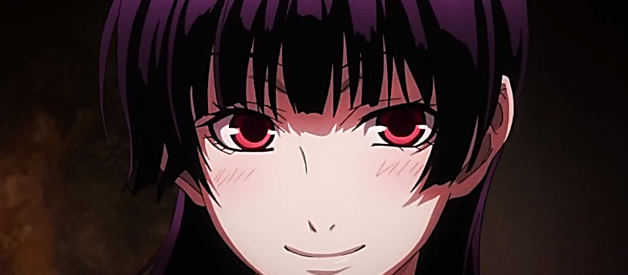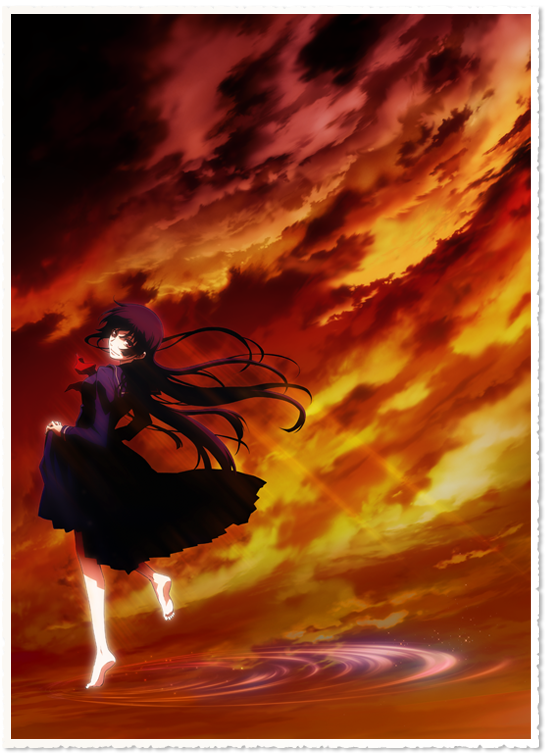 Artwork by Silver Link animation studio. All rights go to SILVER LINK., Inc. Posted on the Tasogare Otome X Amnesia Wiki by Okashira ? Imbued with Gold ? .
Artwork by Silver Link animation studio. All rights go to SILVER LINK., Inc. Posted on the Tasogare Otome X Amnesia Wiki by Okashira ? Imbued with Gold ? .
Sorry for not starting this article off on some thought-provoking anecdote, but I need to give you, the reader, a bit of a heads up. I cannot really discuss this anime?s merits without spoiling major plot points, hence I have divided this review into a spoiler-free and spoiler section. The former is what you?re reading right now, however this section will be brief. If you?re looking for a more detailed review, I would recommend the purchasing and viewing of this work first before returning to this review. However, before you make your inevitable departure, I?d like to give this anime a glowing recommendation. While it certainly has its failings, its narrative is ultimately compelling with its memorable lead heroine, moving psychological drama and poignant themes. Please, if you have money and time to spare, give this anime a fair go. Unlike the previous work I reviewed, it is not hard to find a purchasable copy for this anime. However, like Mizutama Honey Boy, it is rather obscure, and has not sold as many copies as it deserves.
Dusk Maiden of Amnesia is an anime by Silver Link and is directed by Shin ?numa, a man most famous for directing Ef: A Tale of Memories, an anime adaptation of an adult visual novel. I bring up this man?s portfolio with purpose, as I strongly advise against watching Dusk Maiden without having first watched Ef. The reason is not for continuity; they?re two completely different shows with separate narratives, characters and themes. However, I feel Ef is more accessible to those unfamiliar with ?numa?s work, and ergo I feel that potential newcomers should start there.
Dusk Maiden chronicles the life of its lead heroine, Yuuko Kanoe, or lack thereof as she is, in fact, a ghost. However, she is not the kind to be draped in white bed sheets or making eerie noises. She is the spirit of an ordinary schoolgirl who died many years ago in the abandoned wing of Seikyou Academy, and that is how she appears to those who can see her. Therein lies the problem: hardly anyone can actually see her (she is a ghost after all). Her isolation from human interaction has left her distraught and has imbued her with a sense of melancholy.
Yuuko seemingly defies all the archetypes surrounding ghosts. Instead of possessing a horrid appearance, she appears as a young schoolgirl. Instead of desiring to haunt or frighten away unwary interlopers, she desperately longs for their presence and companionship. Instead of giving the audience a quick jump scare here or there, the show explores themes of loneliness, absence and existentialism though her character.
While of all this may sound somewhat dreary, Yuuko is not a stick in the mud. She has a lighthearted and energetic persona, in spite of her desperate circumstances; always trying to maintain a level of optimism and exuberance. This eventually pays off upon meeting Teiichi Niiya, a male student who has the ability to see her, for reasons that are admittedly rather poorly explained.
The two quickly form a friendship and an eventual romance. With this, Yuuko finds the human connection she was seeking (though that is not to say it remains in permanency, as the show revisits the theme of loneliness many times). However, in spite of finding a companion, she knows nothing of her past. The circumstances preceding and surrounding her death are entirely mysterious, and this absence of detail is not helped by her having no memory of the event.
Thus, we are given the title of the show, and the two leads set off on a drama-filled and heartfelt romp as they try to uncover the secrets of Yuuko?s past, all while meeting some colorful supporting characters along the way.
All that being said, it is important not to approach this anime like a detective drama, as let me just say for the record, it isn?t. The show is more of a character study of Yuuko and her psychological struggles. The secretive nature of her passing is more a narrative tool used to build up the drama?s suspense, rather than being a storytelling goal in and of itself. However, the drama itself is incredibly compelling, and is the primary reason I would recommend picking up this show. It confronts its themes with maturity and nuance, while simultaneously not treating the leading lady?s character as a prop to do so. Yuuko eminently feels like she has her own personal desires, wishes and goals separate from the screenplay?s intentions, and her persona is all the more memorable for it.
I cannot go into more detail without spoiling the show, so this is where the spoiler-free section of the review will conclude. Please feel free to return to this review after you have purchased and viewed this anime (or continue reading if you do not care about spoilers).
Author?s Note: To make this review more confusing, I have split the spoiler section further down into two subsequent parts, part one detailing the show?s merits and part two detailing its missteps. While these categories are admittedly cliched, they are just a way for me to structure my thoughts into something coherent and presentable.
The Merits
Yuuko Kanoe
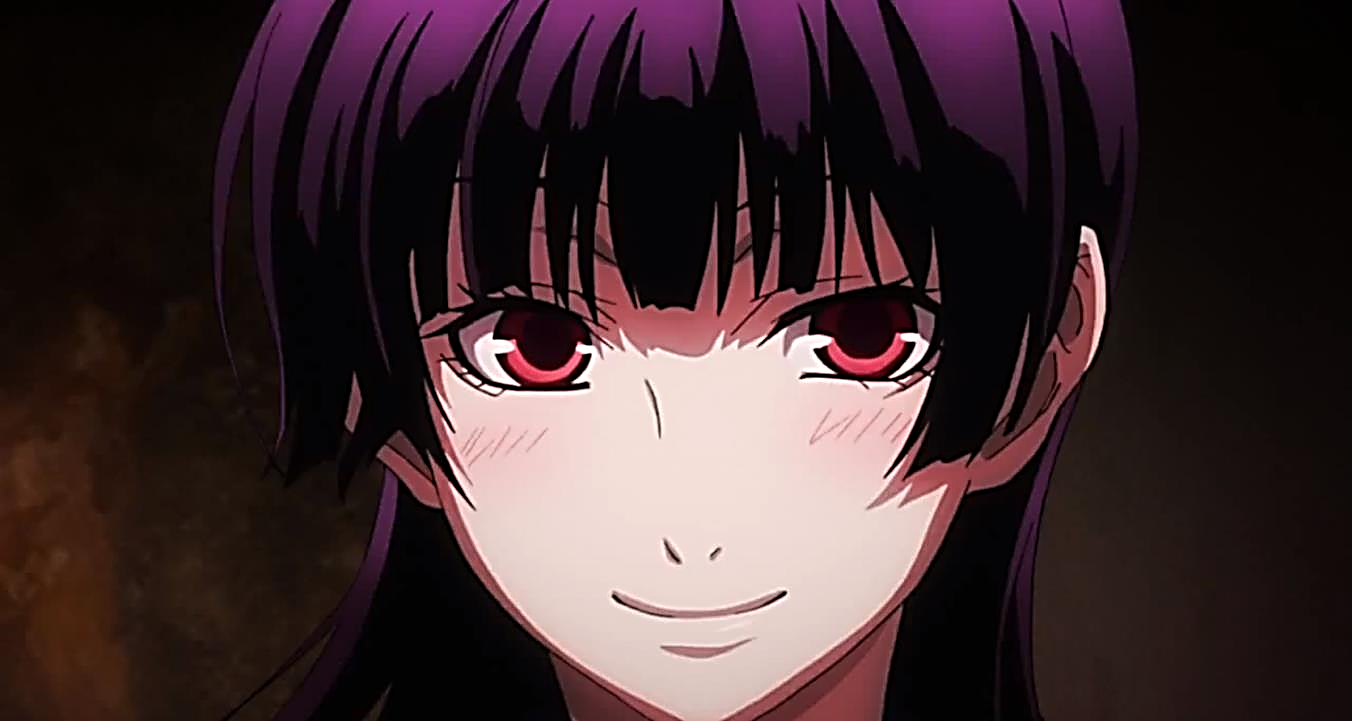 Artwork by Silver Link animation studio. All rights go to SILVER LINK., Inc.
Artwork by Silver Link animation studio. All rights go to SILVER LINK., Inc.
Firstly, let us start with the namesake of the whole show, the Dusk Maiden herself: Yuuko Kanoe.
Yuuko, without a single whit of sarcasm, is one of my favorite protagonists not only in anime, but in narrative works in general. She is lighthearted, energetic, witty, sarcastic, humorous, articulate and introspective. She embodies all these traits with a likable and relatable attitude, never using her humor obnoxiously or to irritate other characters. She is just trying to make light of an otherwise grim set of circumstances.
However, what separates her from merely adopting the happy-go-lucky archetype, and what makes her character truly memorable is the grey morality of her humanity. This is a character far from the established tsundere and yandere archetypes that have embedded themselves into the anime industry. Yuuko does and says things throughout this show that are downright despicable. There are scenes in which she embodies nothing but anger, hate, rage and bitter resentment. However, the darker side of her psyche is never acted upon out of malice or cruelty, but is merely done out an understandable retaliation against all the wrongdoing that has beset her.
Yuuko has a past filled with both mistreatment and abuse, not only in regards to the circumstances surrounding her death, but the lack of acknowledgement others have for her existence. So, when she lashes out at others, it is not to portray her as unlikable or heartless, but merely that her desperation in having to confront overwhelming hardship sometimes pushes aside her morals. She is not immoral, though; she is only human. This nuance is one of the show?s most endearing qualities.
In spite of all this drama, as stated, Yuuko is not a stick in the mud. Throughout the show she manages to maintain a fun and energetic persona, and the character is thoroughly entertaining in terms of her words, mannerisms and comedic countenances. From her first scene of screen time she had me laughing with a constancy; her memorable quips and eccentric expressions instantly endeared her character to me.
Speaking of which, I would like to talk about her debut scene, as I feel it illustrates the merits of her character. It happens to be the show?s opening scene, and from the start, it is making quite the impression. The scene is composed, shot and edited in a way that is both inventive and clever. It initially shows the character of Momoe Okonogi, a fellow colleague and friend of Teiichi Niya, delivering a comedic monologue in the Paranormal Investigations club room, a group founded by both Yuuko and Teiichi in order to investigate the former?s death. However, the camera often ignores Momoe throughout the scene, instead focusing on what initially appear to be inanimate objects, which then suddenly start defying every sense of the word. They start moving about the room in an animated fashion, seemingly being manipulated by an unseen, external force.
The scene then replays, but this time we see that the animation of these objects is simply being caused by Yuuko?s antics, which she is performing both to try and gain Momoe?s attention and to amuse herself.
For example, when the scene first plays we see Momoe leisurely writing in a notebook when her pencil?s graphite breaks, causing the tip to fly across the room and land at the end of a desk. It lands next to a keychain, which then suddenly moves to knock the piece of lead off of the table, causing Momoe to look over at it out of curiosity.
 Artwork by Silver Link animation studio. All rights go to SILVER LINK., Inc.
Artwork by Silver Link animation studio. All rights go to SILVER LINK., Inc.
But when the scene then replays, we see that the keychain was being manipulated by Yuuko in order to try and gain Momoe?s attention, which leads to her waving with excitement in thinking that she has achieved this.
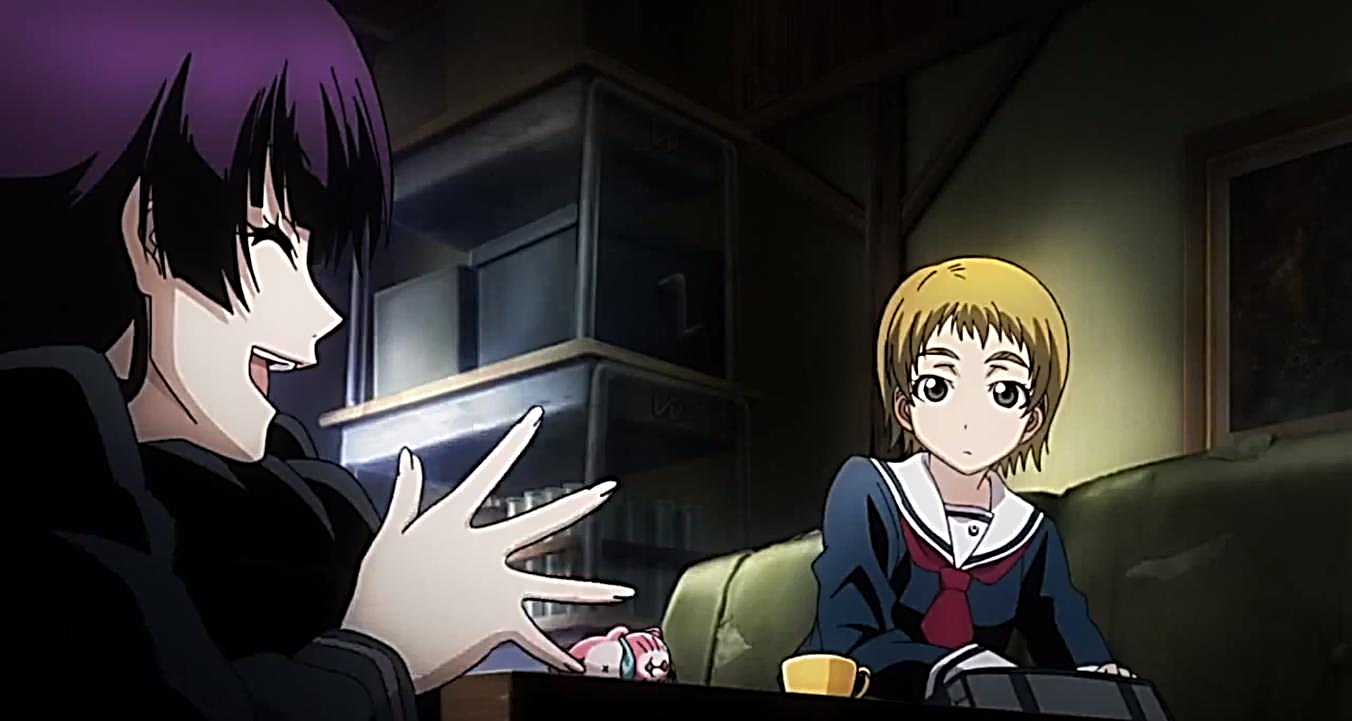 Artwork by Silver Link animation studio. All rights go to SILVER LINK., Inc.
Artwork by Silver Link animation studio. All rights go to SILVER LINK., Inc.
Which leads to us, the audience, feeling inevitable sympathy when Momoe fails to notice Yuuko?s presence, causing her to turn to dejection.
 Artwork by Silver Link animation studio. All rights go to SILVER LINK., Inc.
Artwork by Silver Link animation studio. All rights go to SILVER LINK., Inc.
Another example is when Momoe is seen reading some reports, which then start to levitate in the air when she turns away her attention.
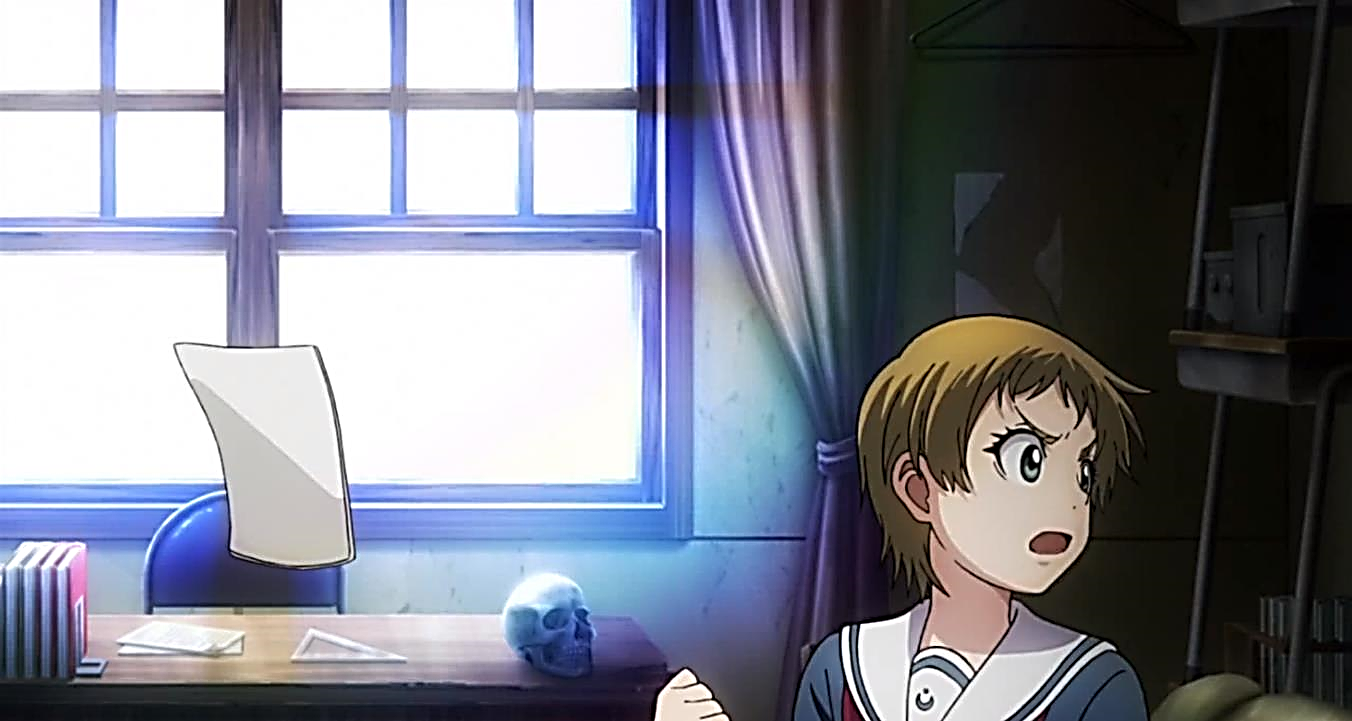 Artwork by Silver Link animation studio. All rights go to SILVER LINK., Inc.
Artwork by Silver Link animation studio. All rights go to SILVER LINK., Inc.
But when the scene plays again in retrospect, we see that it is Yuuko picking up the reports . . .
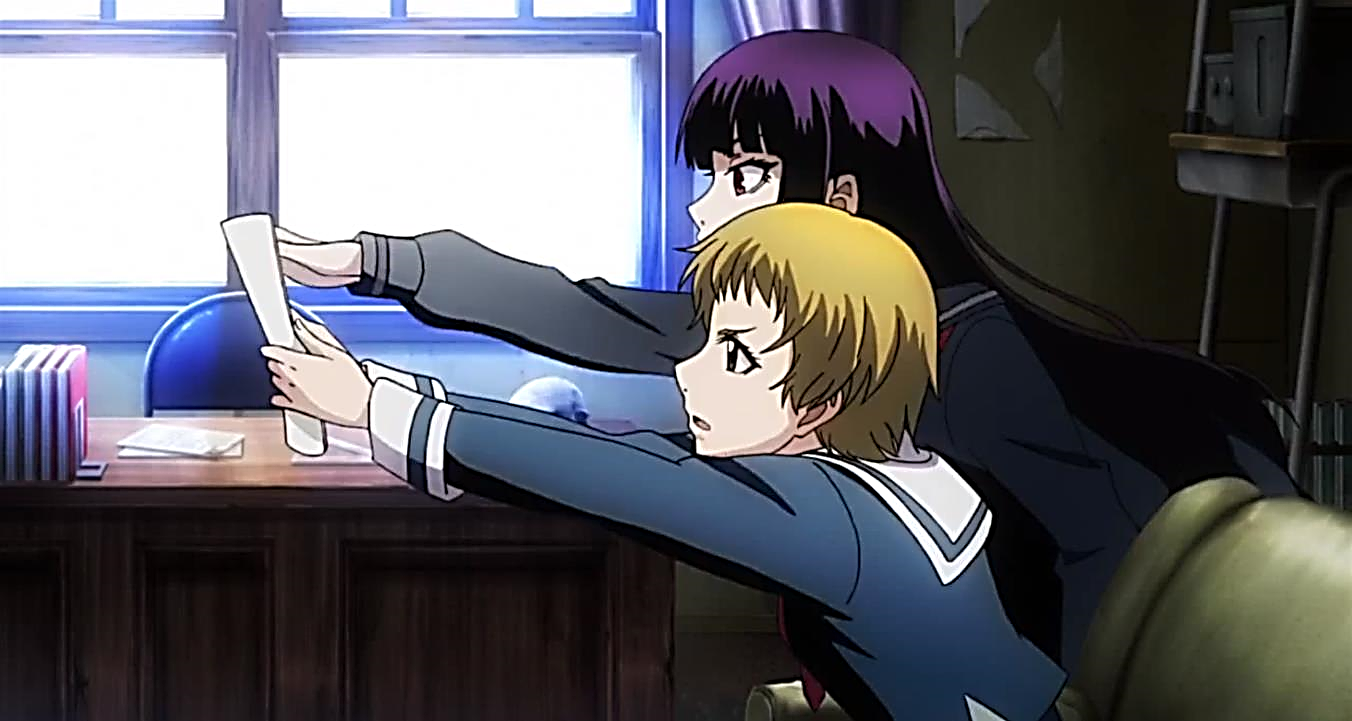 Artwork by Silver Link animation studio. All rights go to SILVER LINK., Inc.
Artwork by Silver Link animation studio. All rights go to SILVER LINK., Inc.
. . . and then proceeding to read them out of simple curiosity.
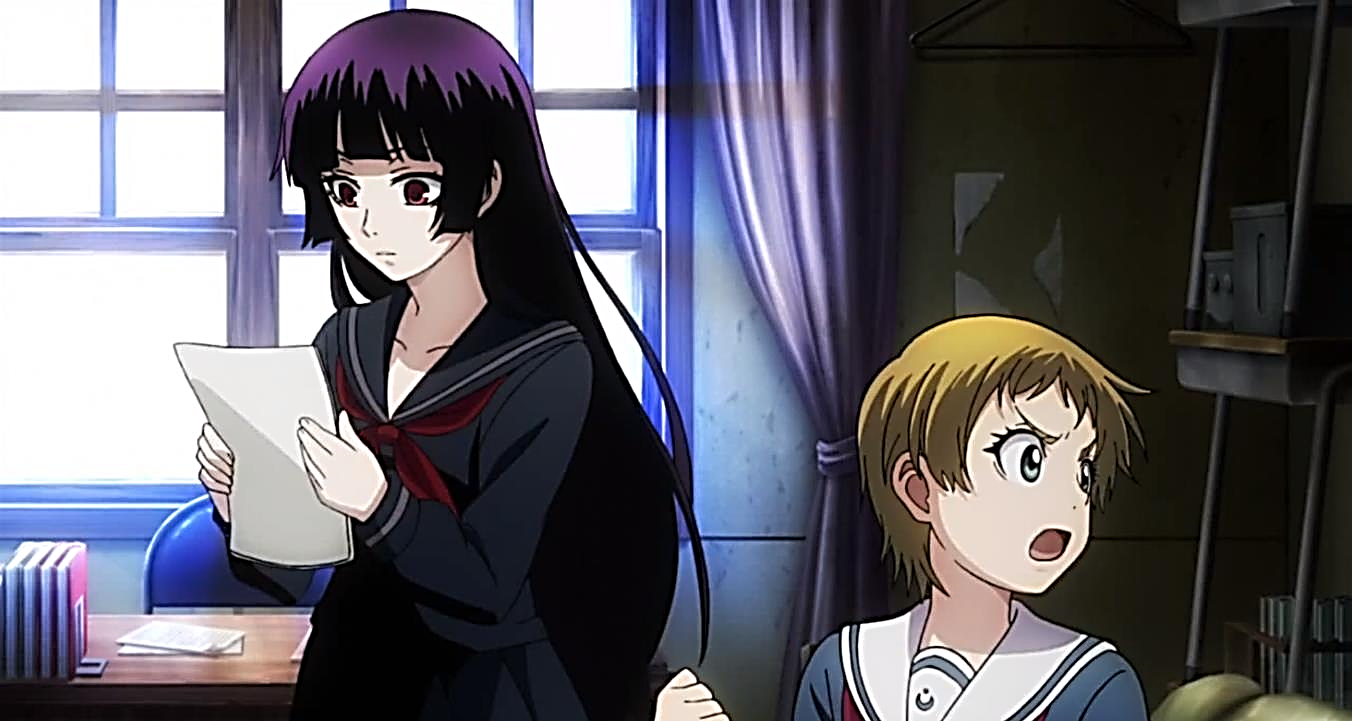 Artwork by Silver Link animation studio. All rights go to SILVER LINK., Inc.
Artwork by Silver Link animation studio. All rights go to SILVER LINK., Inc.
The hilarity of this scene is not only compounded by how seemingly dense Momoe is, but also by her dramatic delivery of a monologue about how experienced and perceptive she is as a paranormal investigator, without her seeing the ghost right in front of her. Yuuko also sarcastically mocks her dull-witted senses throughout the scene, adding to its levity.
The scene is not only used for comedic value, but it also helps the audience connect with Yuuko?s character. When confronted with her absence in Momoe?s perception, she does not wallow in abject self-pity but instead turns to lighthearted sarcasm in order to overcome its associated pain. This upbeat attitude is an important component of what makes her likable and relatable. It also allows for the scene to touch the bases of both comedy and drama simultaneously. The audience can laugh along with Yuuko?s sarcastic banter, while at the same time have a rapport with the character?s frustrating attempts to have her presence appreciated.
This is also sold by her expressive animation. Her facial expressions throughout the show are striking, varied, endearingly emotive and sometimes utterly hilarious. With the substantial amount of emotions contained within her character, and with the number of taxing emotional experiences that she goes through, this was something that the animators needed to deliver on. They did not disappoint. During my review process, I often muted the audio and still found Yuuko?s bubbly and sassy persona being communicated to me through just her facial expressions. The animators talent in this one aspect cannot be overstated. I think it is a small wonder that the title card of every episode is a merely a showcase of Yuuko in different states of expression.
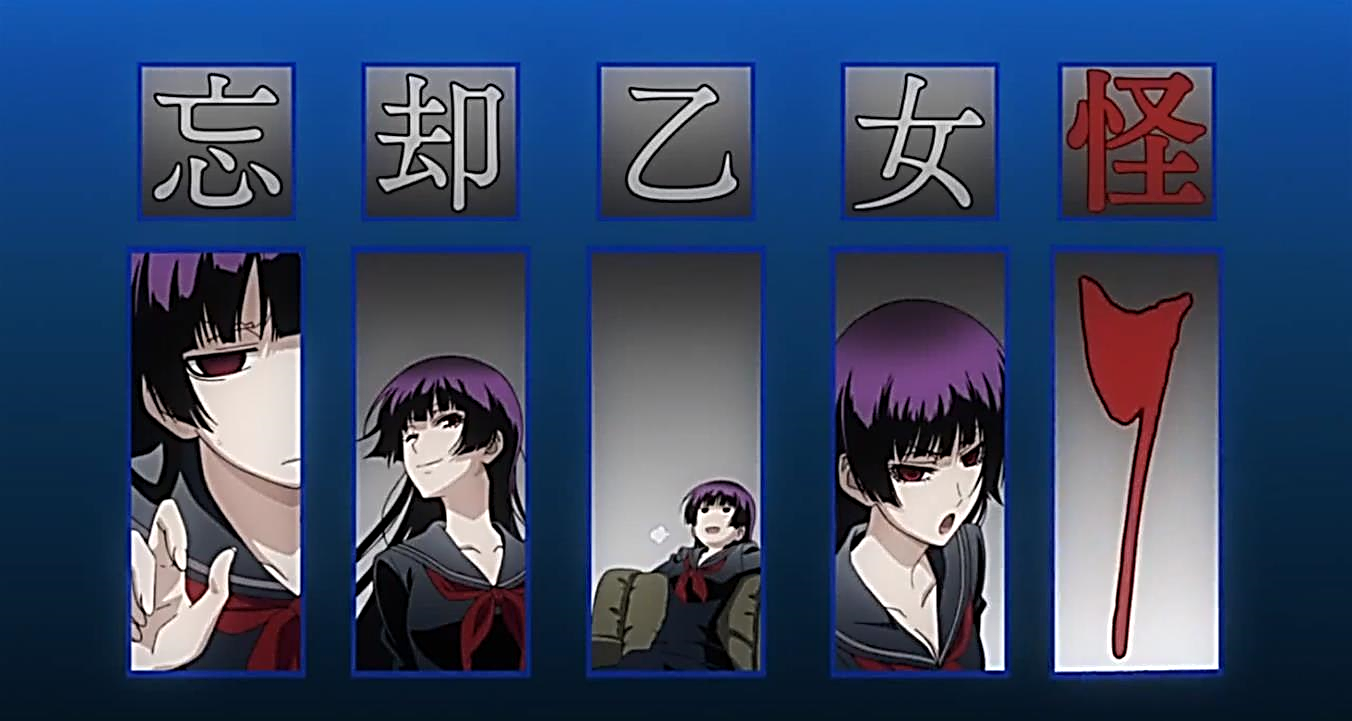 Artwork by Silver Link animation studio. All rights go to SILVER LINK., Inc.
Artwork by Silver Link animation studio. All rights go to SILVER LINK., Inc.
Last, but certainly not least, I would like to praise the performance of Emily Neves as Yuuko Kanoe. I watched both the Japanese Sub and English Dub versions of this show for this review, and while Yumi Hara?s performance deserves its praise, I ultimately feel the latter wins out over the former, at least in regards to the leading lady. Neves embodies the character with an authenticity that is sadly a rarity when it comes to anime dubs, and her work for this show simply cannot be overstated. From her energetic euphoria, to her somber existentialism, to her tongue-and-cheek wit and to her lamentations of despair, Neves nails the emotional complexities of Yuuko?s character with her delivery of every line. For every review that I have read for this show (what little of them there are), none of them make any light of or touch upon Neves? portrayal. So Emily Neves, allow me to say thank you. Your work on this show does not get the credit it deserves.
Art Direction
Silver Link, at least for me, has always been the little studio that could, and Shin ?numa the director that could make them do it well. It?s no secret that a lot of Japanese animated productions (outside of Studio Ghibli) suffer from limited budgets, and Silver Link is no exception. What separates them from other studios is that they don?t aim for concepts that are out of reach. Their output consistently uses their low budgets to their advantage, not going for the overly-animated cuts or bombastic action sequences of other anime studios, instead using techniques such as color, lighting, shot composition and editing to make their works stand out. And I do think it is their art direction rather than their animation that is worth praising here, as in most scenes, there is a lack of it. Most of ?numa?s portfolio, such as Ef: A Tale of Memories/Melodies, Kokoro Connect and of course Dusk Maiden of Amnesia, is comprised of psychological romances that do not require the overly animated sequences of action or shonen anime, instead relying on the aforementioned techniques. What I like even further about ?numa?s work is his ability to use these budgeted techniques for storytelling purposes.
Take the opening scene we analysed in the previous section for example. Now, a cynically-minded critic might simply write it off as an excuse to reuse animation, and I would surprisingly be inclined to agree, as no doubt that is part of the reason why the scene is repeated. However, the reason it sits well with me in this anime, and not in others, is that it is being used for a storytelling purpose, that being to allow the audience to immediately identify with Yuuko?s character. It also allows us to see the exact same scene in two different ways. When the scene first plays we are watching it with bemused curiosity, as we see this young schoolgirl go about her daily routine while being drawn to the rather sporadic motion of the objects around her. When she finally notices, and when the scene plays again in retrospect, we are watching it with a sense of comedic irony, as the worries of Momoe that the animated objects are the actions of a terrifying poltergeist turn out to be nothing more than the afternoon antics of a bored schoolgirl only trying to keep herself entertained.
These budgeted techniques are also used for the sake of visual flare, and when combined with the aforementioned storytelling purposes, they make for some memorable scenes. While the limited budget is certainly on display, mainly due to a lack of eye-catching animation, these scenes make up for it in terms of color, lighting, visually pleasing camerawork and vivid imagery.
For reference, just look at the shot below.
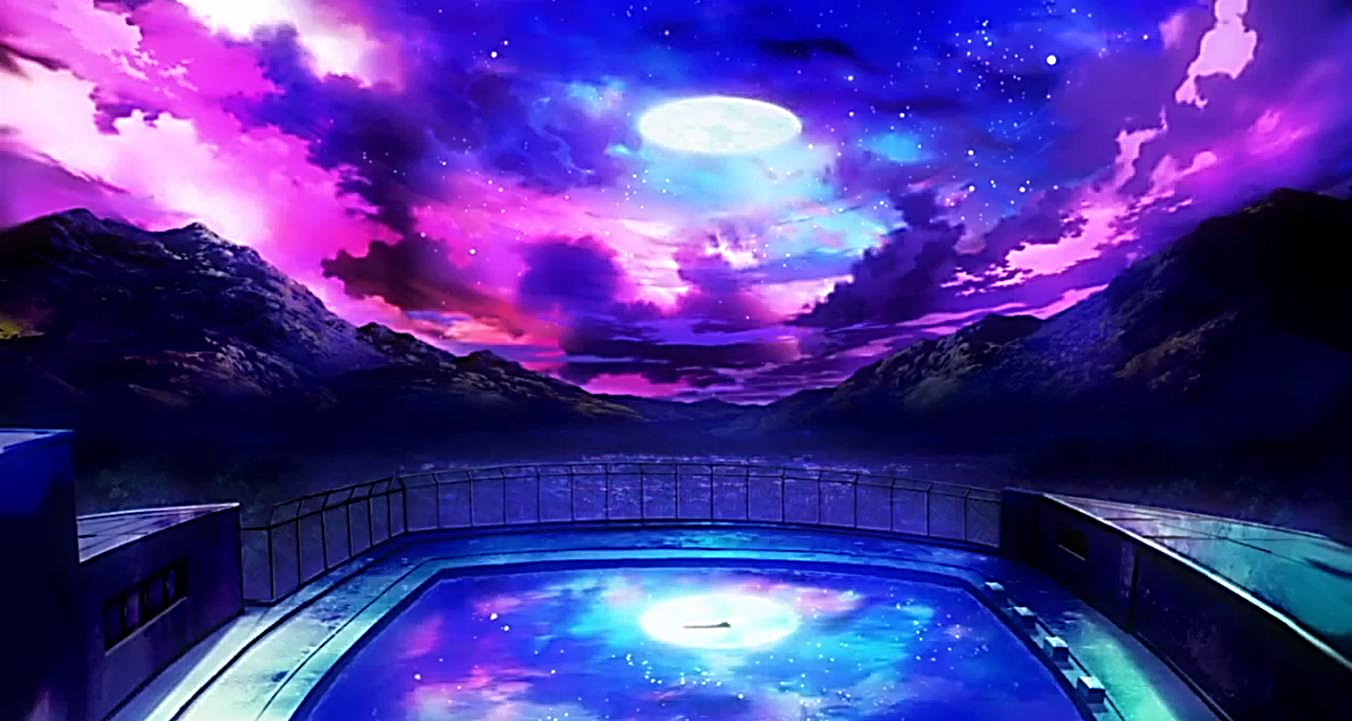 Artwork by Silver Link animation studio. All rights go to SILVER LINK., Inc.
Artwork by Silver Link animation studio. All rights go to SILVER LINK., Inc.
The only animation in this scene is Yuuko slowly drifting in the pool in the foreground, and yet, it still manages to capture the attention of the viewer. It is not only its striking color pallet, intense use of saturation and contrast, and the imposing panorama of its establishing shot that makes it work, but also how the aesthetics of the night sky are reflected in the swimming pool?s waters. Despite her not being the subject of the shot, Yuuko is still in the center of the foreground, allowing viewers to still relate to the imposing panorama of the background through her perspective. The moonlight centered on her presence in the shot is also a nice touch. These cinematic techniques allow the scenes of this show to truly shine, in spite of their low budget.
Psychological Drama
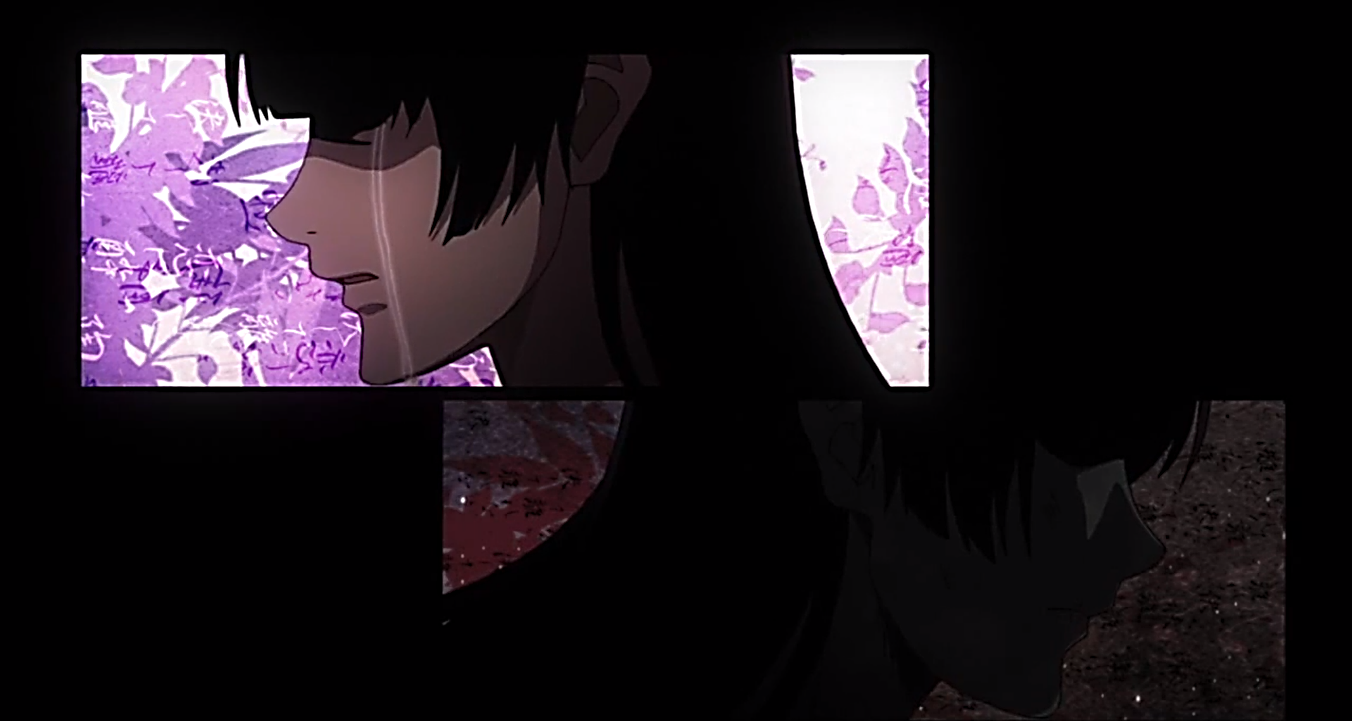 Artwork by Silver Link animation studio. All rights go to SILVER LINK., Inc.
Artwork by Silver Link animation studio. All rights go to SILVER LINK., Inc.
The main source of drama for the show is the split personality of Yuuko?s psyche, as the trauma of her death was so damaging to her mental state that it forced her to heap all of her negative emotions onto an alternative persona, referred to by the show as Shadow Yuuko. From beginning to end, it is incredibly compelling, gripping, and somewhat emotionally draining. This is not so much a critique of the show, more so a warning to viewers. ?numa?s direction has a habit of addressing some rather heavy and hard-hitting subject matter, and this is a quality that I like about his portfolio, in that he is willing to tackle themes that other directors simply are not. This is far from the typical teenage drama that encompasses most traditional romantic comedies in the anime industry, so if you have an exclusive preference for that sort of material, for which I begrudge you none, maybe skip this one. Let me reiterate that I have no qualms with these sorts of shows, as I myself enjoy the more leisurely viewings of traditional romantic comedies (see my article on Mizutama Honey Boy as an example). All I am saying is that if you have little tolerance for the morbid or macabre, this show is most likely not for you.
Shadow Yuuko has no presence throughout the show?s early episodes, and her existence is more hinted at through subtle foreshadowing (how apt). Some examples include Yuuko?s complete inability to remember her past, her almost absent display of negative emotions throughout the show?s early stages and her apparent lack of motivation to recover her memories, despite her founding the Paranormal Investigations club in order to do so. By the fourth episode, both her memory and the associated negative emotions therein begin to surface. In turn, so does Shadow Yuuko, and this is where the story truly begins.
Again, this is not meant to be a critique. I like that the show takes its time with a subtle buildup, rather than diving headfirst into the psychological drama. However, I feel it is the suspense of said drama that will be a sticking point for some viewers, and somewhat understandably so. Because Yuuko is the ghostly apparition of a deceased schoolgirl, and that there is no real, substantive proof of life after death, some viewers might find her character hard to relate to. While I certainly understand this perspective, I feel this critique misses the point somewhat. The trauma and subsequent mental health issues Yuuko has to go through is more what the audience is meant to latch onto, rather than the spectral state of her existence. Her struggles could be easily equated to those of a victim of abuse or a veteran of war. After all, multiple personality disorder is something that living people have to suffer through, and not so much the departed.
What I like about ?numa?s portrayal of this disorder in particular is its nuance. Shadow Yuuko embodies some terribly uncomfortable aspects of the human psyche: anger, hate, bitterness, resentment. And yet, the show still portrays them as a part of Yuuko?s character. Throughout the entirety of its runtime, Yuuko and Shadow Yuuko never feel like two separate individuals; they instead feel like two sides of the same coin. Where other shows might try to resolve these traits by writing them off as separate from her character, ?numa accepts them as a part of what makes her feel grounded in reality.
This philosophy comes to a head in the eleventh episode, where Yuuko is finally forced to confront her shadowed counterpart, with Teiichi acting as a go-between bridge for both parties. This scene is easily the most emotionally powerful, and thus is my favorite of the series. Teiichi tries to reason with the shadowy figure, as during the prior episode Yuuko managed to transfer her memories to him, allowing him to witness her death.
During Yuuko?s youthful adolescence, her hometown, a small mining village, was being ravaged by a plague. Turning to superstition rather than reason, the town?s council believed that the plague was Godly recompense for building Seikyou Academy on top of a local shrine. With families of townsfolk dying by the day, and with the desperation of their situation pushing them to religious superstition (in a manner that is somewhat analogous to William Golding?s Lord of the Flies), the town?s council decide a human sacrifice must be made in order to appease the Gods, the sacrifice of course being Yuuko. Asagi, a young girl whom Yuuko had nurtured during the plague?s worst days, is falsely believed by the town?s council to be a religious prophet of sorts, and that whomever?s name she speaks must be the sacrifice. When Yuuko tries to free her from the council?s clutches, Asagi accidentally speaks Yuuko?s name as she is calling to her for help, leading to her death. Yuuko is thrown down into a dark basement (where the local shrine is located), to die.
With her leg broken, and in immense pain, Yuuko?s morals are scattered in her final moments. She rages against and curses everyone, from Asagi, to the town?s council and the town itself, finally revealing that this is when Shadow Yuuko was born. Desperately forcing all of her rage and hate onto this alternate persona, Yuuko finally passes away, before being reincarnated as a ghostly apparition due to her fractured selfhood.
Returning to the present, Teiichi says that he feels an immense sympathy for Shadow Yuuko after witnessing the absolutely horrid and callous context of her death. Shadow Yuuko admonishes him for this, saying that she distrusts his sympathies, and that even if they are genuine that they are simply misplaced, as she is aware of all the negative emotions that she embodies. Teiichi confronts her with the moral precept that the entire narrative has built towards, that her shadowed persona is still a part of who Yuuko is, and regardless of the embittered emotions she embodies, she is still the woman that he loves. He says that the rage and hate she feels is only human, and is absolutely understandable given the severity of the trauma she was subjected to in her final moments.
Rather than dismissing this nuance out of hand, the show confronts it with a poetic maturity, and is its most endearing merit.
The Missteps
Production Value
I feel the second part of this review will be somewhat contentious, as most of the points of critique I have to raise can be compliments depending on the scene being addressed, and this point is no exception. While I did say earlier that Silver Link is a studio that often turns their limited resources to their advantage, that is not to say it is a constancy throughout the show. For all their talent, there are a number of scenes that do not have either the aforementioned cinematic techniques nor the storytelling purposes to hide their lacking budgets.
Case in point: silhouetted school students.
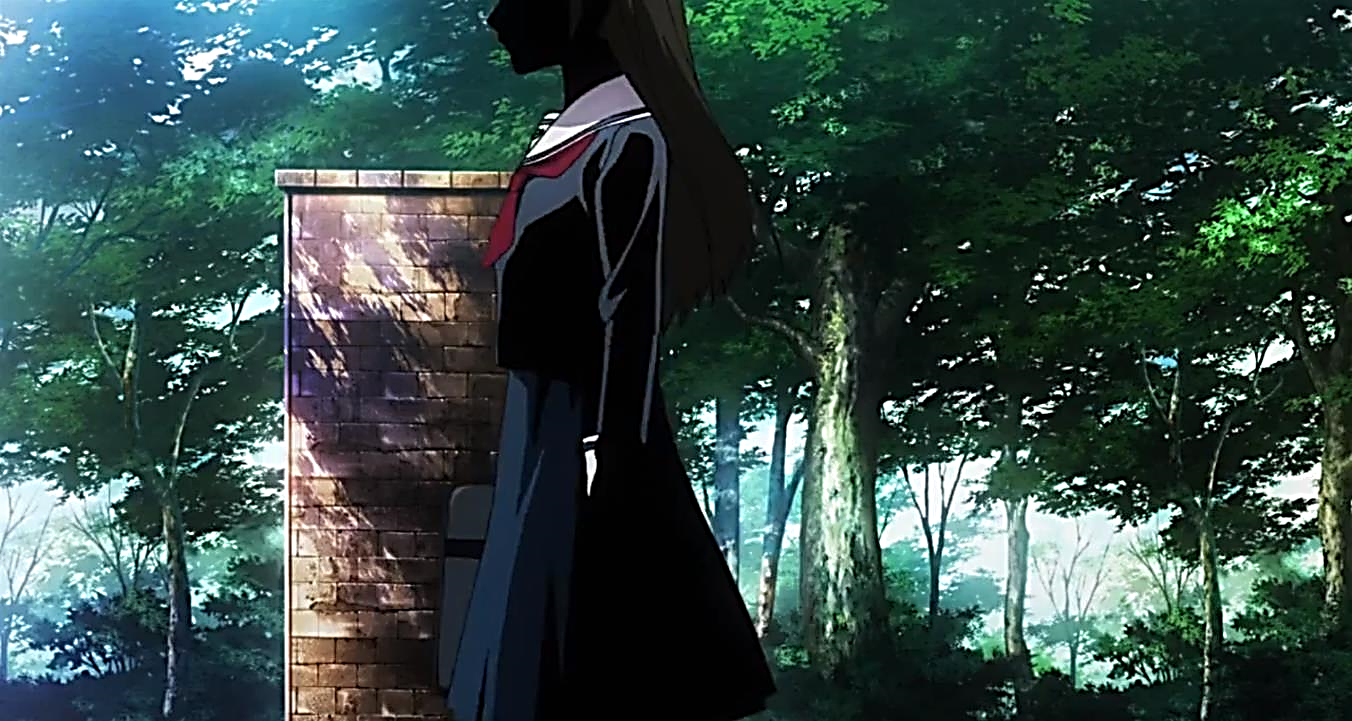 Artwork by Silver Link animation studio. All rights go to SILVER LINK., Inc.
Artwork by Silver Link animation studio. All rights go to SILVER LINK., Inc.
Now, this same budgeted device is used prior to this in episode one, and there it works, because even if it is not visually appealing, it at least ties into Yuuko?s spectral state as a ghostly apparition. It is also used prior to her debut scene, in order to build suspense for her inevitable reveal.
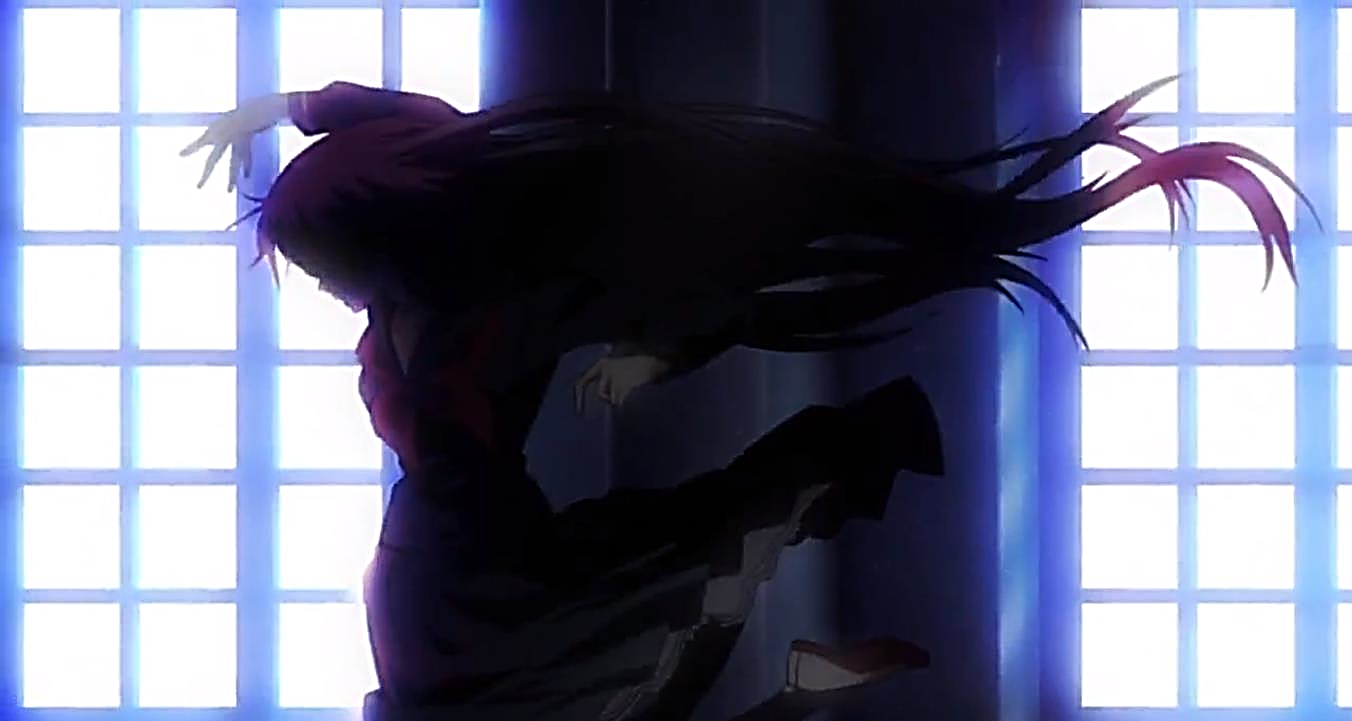 Artwork by Silver Link animation studio. All rights go to SILVER LINK., Inc.
Artwork by Silver Link animation studio. All rights go to SILVER LINK., Inc.
But since background school students have no connection to the story or the characters, nor possessing of any character themselves, their silhouetted cuts serve no tangible storytelling purpose. And since they also lack the visual flair to take its place, these animated cuts simply fall flat. They do not seem to speak to an artistic choice being made by the animators to add to the show?s visual style; they only speak to a lack of time, budget or care to detail the faces of the background school students.
Another example is the rooftop scene of the eighth episode.
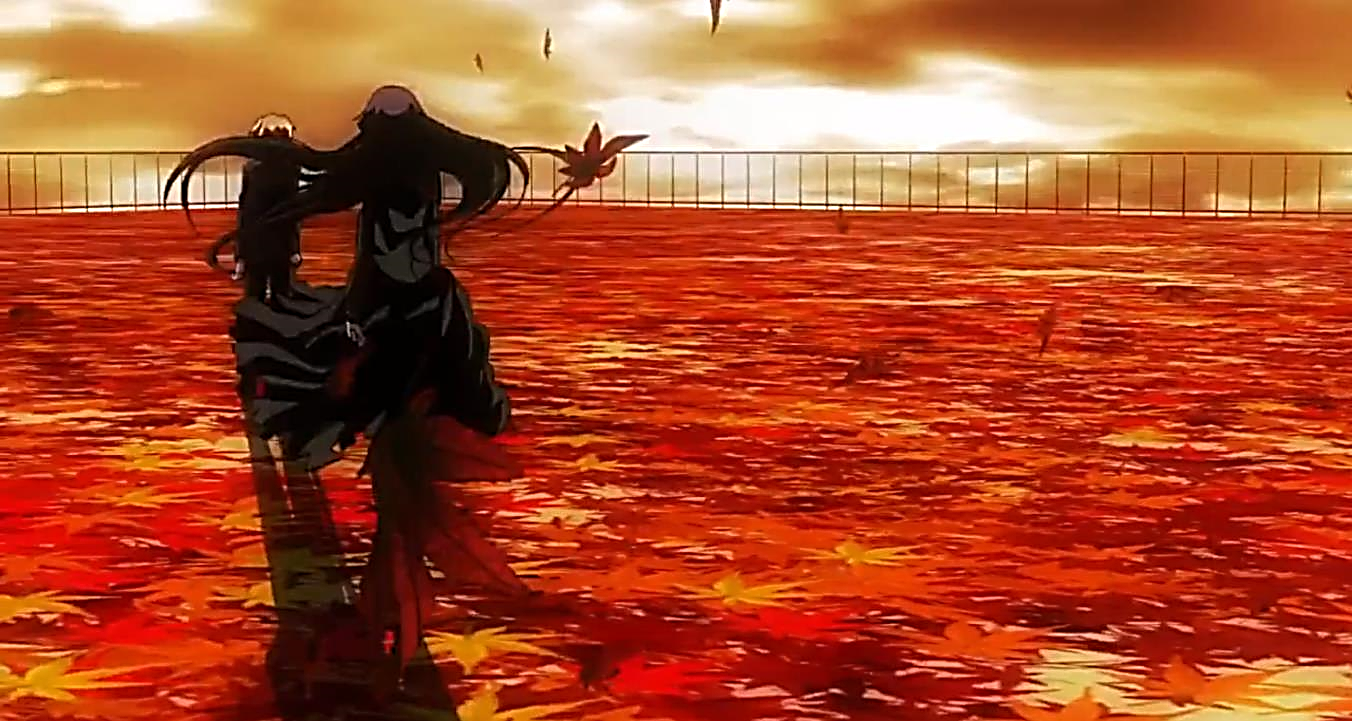 Artwork by Silver Link animation studio. All rights go to SILVER LINK., Inc.
Artwork by Silver Link animation studio. All rights go to SILVER LINK., Inc.
I think the CGI for the autumn leaves and school rooftop speaks for itself, but what is more jarring than its apparent lack of detail is how poorly it blends with the 2D characters. Yuuko is such an endearingly expressive character, and I have already thoroughly praised in this review her emotive animation, and the meticulous detail contained therein. So when you put a character that is so detailed, against a background that lacks any sense of the word, it simply sticks out like a sore thumb.
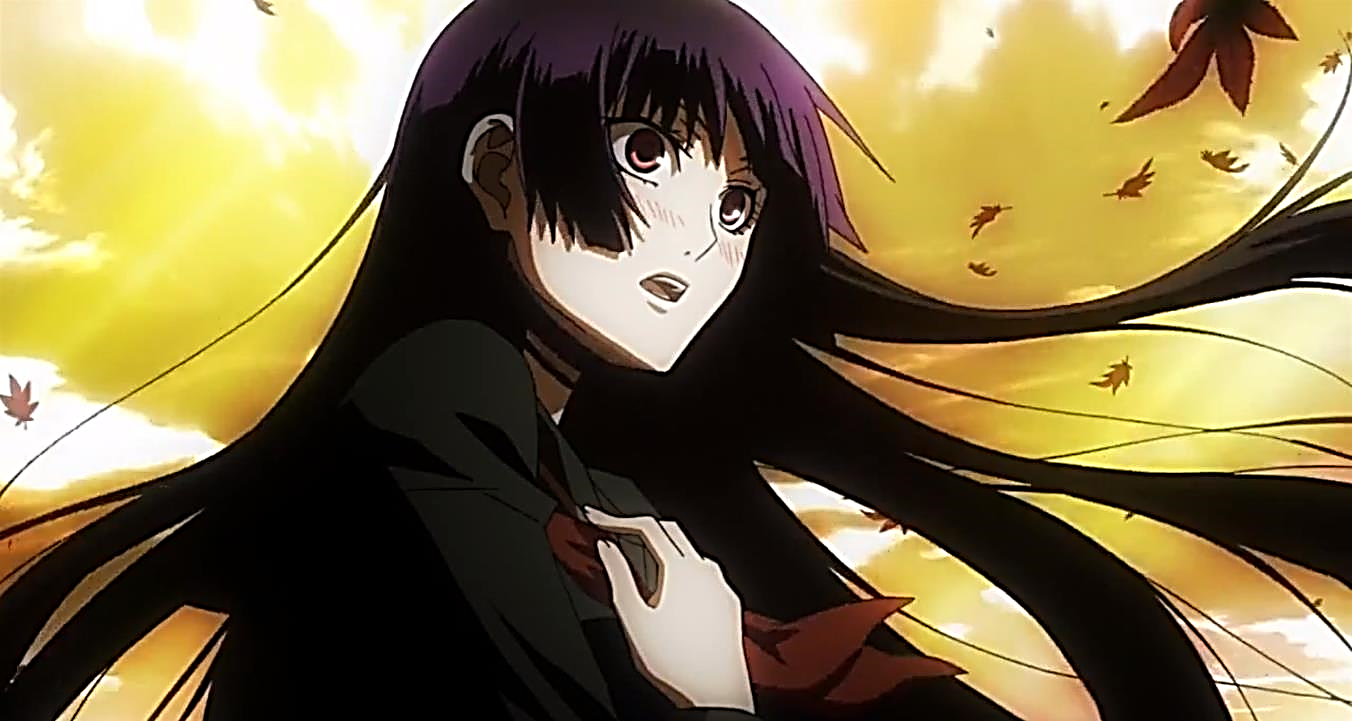 Artwork by Silver Link animation studio. All rights go to SILVER LINK., Inc.
Artwork by Silver Link animation studio. All rights go to SILVER LINK., Inc.
Supporting Characters
This point of critique will again be contentious, but I still feel that it needs to be made. Now, potential viewers may attribute the lack of development for the supporting characters to the show?s title. I would be inclined to agree; the focus should be on Yuuko, and it rightly is, as her development is where the show?s writing is strongest. Yuuko?s psychological drama is incredibly compelling and gripping, and is where the show?s writers should have placed the bulk of their attention. However, I cannot help but feel that this came at too severe of an expense for the supporting characters, and that more time could have been spent on them.
The supporting characters of note are Kirie Kanoe (who is actually the granddaughter of Yukariko Kanoe, Yuuko?s sister) and the terribly dense Momoe Okonogi. The former is a stoic know-it-all with some hidden insecurities, and the latter is simply a comedic goofball. That is all the depth to their characters.
This lack of depth certainly does not come from the voice cast. The anime?s English dub has Kirie being voiced by Jessica Boone and Momoe being voiced by Brittney Karbowski. Both bring talent to their roles, with the former?s voice work resonating with me in particular. The subtle apathy in Boone?s delivery, when blended with the character?s rather dry humor, brought an amused smile to my face with a constancy. However, the voice cast?s attempts to inject life into their characters only reveals that they never had much character in the first place.
While Kirie and Momoe have some scenes devoted to them, they never seemed to stick with me beyond their runtime. This is because they have no lasting impact on the greater narrative. That is not to say the supporting characters have no lasting impact outside of these scenes, at least in regards to Kirie. She actively converses with Teiichi on Yuuko?s deteriorating mental state and what can be done to help her. However, it feels that she?s only doing it at Yuuko?s behest. The best supporting characters have desires that are at least somewhat congruent with the greater narrative, and this is a quality that Kirie lacks. Whenever she is acting on her own desires, and desists helping Yuuko, it rings only with regretful irrelevancy.
The Finale
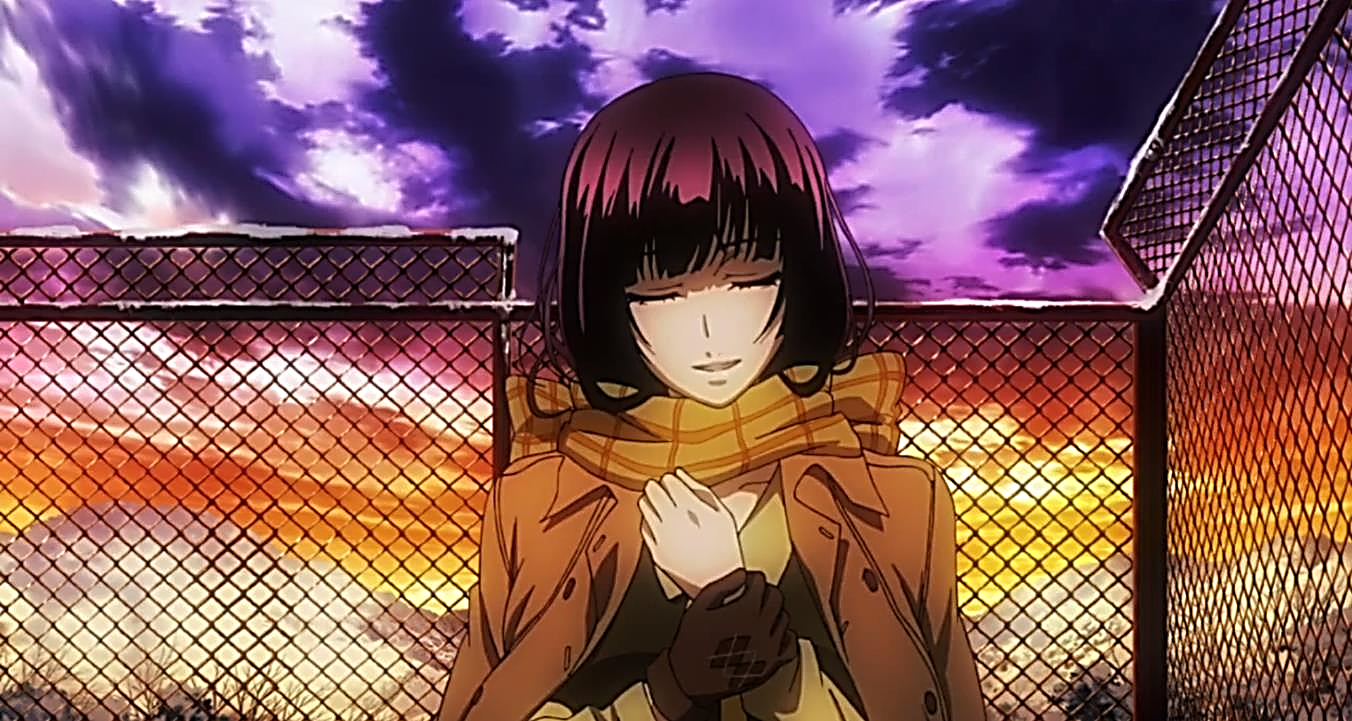 Artwork by Silver Link animation studio. All rights go to SILVER LINK., Inc.
Artwork by Silver Link animation studio. All rights go to SILVER LINK., Inc.
This point of critique will have little contention, as I feel it is singularly the show?s greatest flaw. Before I continue on, I feel it is a duty of sorts to beseech readers to purchase and view both Ef: A Tale of Memories and Dusk Maiden of Amnesia before consuming this section, as it contains heavy spoilers for both shows.
If you have watched both shows, which again I must beseech you to do, you may have noticed a slight problem brewing for this show?s finale in the Psychological Drama section of this review. The show is ultimately comprised of twelve episodes in total, and yet Yuuko?s psychological drama is resolved by episode eleven. This leaves viewers with the pertinent question of what subject matter will take its place in the finale. The answer is a little disappointing.
The conclusion of Dusk Maiden of Amnesia is as follows. Both leads decide to go on a date, after overcoming overwhelming hardship. They eat lunch together and spend the day indulging in romantic activities. At the apex of their happiness, Yuuko addresses the inevitable drama of the episode: that the two of them must go their separate ways. Teiichi predictably protests this, which Yuuko then admonishes him for, saying that she wants them to have a ?nice parting?. The two then say their farewells, before a plot twist reveals that this is not necessary. The two decide to continue their lives together as the show concludes.
Does this sound familiar?
The finale of the show is simply a retooled plotline from Ef: A Tale of Memories. Honestly, being familiar as I am with ?numa?s work, this does not surprise me, as he directed both shows. Knowing that simply does not make it palatable. Not only is this same finale better executed in Ef, but I also feel it potentially damages the experience for first-time viewers, as they may mistakenly think that it is the guilty plagiarist of the two, when it was really the original proponent of the conclusion.
This borrowed plotline might be acceptable to my judgement if it was well executed, but as I have been alluding to until this point, it isn?t, as the dramatic stage to support its suspense is absent. In the twelfth episode, Yuuko states that the reason she must part with Teiichi is because her fractured selfhood has been resolved, and now that she has no earthly attachments, she will begin to fade away, saying that the deceased do not belong with the living. This might be a satisfying explanation on its own terms, but the finale sabotages this attempt with its plot twist, that being that the reason they can continue their romance is because of their final kiss. Its blatant absurdity speaks for itself, but what is more troubling is the apparent contention that it raises. If their romance was already enough of an ?earthly attachment? for Yuuko to stay, then there was no tangible reason for them to part in the first place, rendering this plotline meaningless.
The show goes from completely ignoring their romance, to using it as a crux for a happy ending. Ending on a high note is not the problem here, as another point of critique I have is that the forced drama disrupts any potential euphoria. Whenever the episode kept its attention solely on the romance, I enjoyed its runtime. Had the finale been our two leads sharing a simple date it would have sailed by without a single problem from me. The problem is not including some drama as an alternative; the problem is that the drama is nonsensical, and so I do not imagine that it will stay with viewers.
I am sure ?numa and the writers had the best of intentions, but unfortunately, they are just absent from the final product.
Conclusion
It?s important to note that while my points of critique may make Dusk Maiden of Amnesia look somewhat like a failed product, it is certainly not the intent. If you have been reading this review from the start, and if you are miraculously still here somehow, you will know I gave this anime a glowing recommendation to any potential viewers, and I still do. Its memorable lead heroine, moving psychological drama and poignant themes will stay with me for the rest of my years, and while the diamond has its fair share of nicks and scrapes, it still shines brightly. Copies are freely available for purchase on Amazon, so if I have hopefully persuaded you with this review that it is worth your time and money, please give it both in spades.
While this review was a long time coming, it was also a labor of love to put together, with my passion for this anime?s merits pushing me every step of the way. My thanks to both Shin ?numa and Silver Link for putting your passion and creativity into one of my favorites in the anime medium.
Hopefully, with this review now written to its completion, your efforts will not go unappreciated.
If you enjoy the work I have written on Medium, please consider supporting me on Patreon with the link below:
